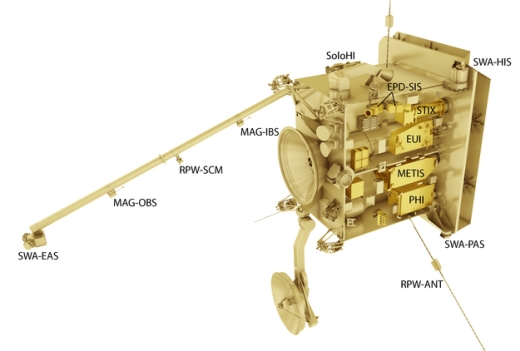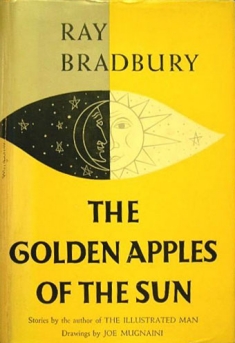Alex Tolley mentioned Ray Bradbury’s story “The Golden Apples of the Sun” in connection with my first article on the Parker Solar Probe, and it’s a short tale worth remembering in connection with a mission flying so remarkably close to our star. First published in 1953 in a Doubleday collection of the same name, the tale is a short, mythic take on dangerous questing, with its main character, the unnamed captain, a figure something like Melville’s Captain Ahab. His goal is to fly to the Sun’s surface and retrieve some of its fire:
The captain stared from the huge dark-lensed port, and there indeed was the sun, and to go to that sun and touch it and steal part of it forever away was his quiet and single idea. In this ship were combined the coolly delicate and the coldly practical. Through corridors of ice and milk-frost, ammoniated winter and storming snowflakes blew. Any spark from that vast hearth burning out there beyond the callous hull of this ship, any small fire-breath that might seep through would find winter, slumbering here like all the coldest hours of February.
The ship and crew, fighting malfunctioning equipment, fall in their cryogenic ship “like a snowflake into the lap of June, warm July, and the sweltering dog-mad days of August.” It’s Bradbury in full poetic mode, not one of his best tales but one that does capture a bit of the natural human awe at stellar immensity. As for the Parker Solar Probe and the European Space Agency’s Solar Orbiter mission, neither will ‘touch the Sun,’ though the former will close to about 6.2 million kilometers, with the Solar Orbiter at 42 million kilometers.
Image: The dustjacket of the first edition of Bradbury’s collection The Golden Apples of the Sun. The title comes from the lush Yeats lyric The Song of Wandering Aengus. In an interview late in his life, Bradbury recalled: “Maggie [his wife] introduced me to romantic poetry when we were dating, and I loved it. I loved that line in the poem, and it was a metaphor for my story, about taking a cup full of fire from the sun.”
These missions are framed so as to study the near-Sun environment from different perspectives. Both are scheduled for launch in 2018, the Solar Orbiter in October and the Parker Solar Probe in July. What I’m seeing here are two complementary ventures, both examining the interaction between the Sun’s atmospheric gases and its magnetic field. Comparing the datasets should give us our best understanding yet of the inner heliosphere.
The key issues for the Solar Orbiter are listed on this European Space Agency page:
- What drives the solar wind and where does the coronal magnetic field originate from?
- How do solar transients drive heliospheric variability?
- How do solar eruptions produce energetic particle radiation that fills the heliosphere?
- How does the solar dynamo work and drive connections between the Sun and the heliosphere?

Image: Payload accommodation onboard Solar Orbiter. In this rendering, one side wall has been removed to expose the remote-sensing instruments mounted on the payload panel. The SPICE [Spectral Imaging of the Coronal Environment} instrument (not visible) is mounted to the top panel from below. Credit: ESA.
What Solar Orbiter brings to the mix is an orbit that will allow us to get close-up views of the Sun’s polar regions, with images from latitudes higher than 25 degrees. We should be able to see solar storms building up over an extended period from the same vantage point, because when traveling at the highest velocity along its orbit, Solar Orbiter will come close to matching the speed of the Sun’s rotation on its axis. We will be able to track solar storms for days.
Remember that many of the Sun’s jets originate in the areas around the poles, meaning we need more data about the magnetic field and plasma flows there to delve more fully into the process. These are not regions that are visible to us from Earth.
Understanding the solar wind also helps us consider the feasibility of future propulsion concepts using magnetic sail technologies to ride the solar wind. Meanwhile, the thermal issues a photon-driven sundiver mission will encounter will take center stage as we weigh the performance of the instrument packages on both these spacecraft. A sundiver would pass as close as possible to the Sun before unfurling a solar sail for maximum acceleration. We gain information from the upcoming solar missions that benefits both types of sail technology.
Solar Orbiter will carry a suite of 10 instruments to observe solar activity, 8 of them provided by ESA member states, while the other two are being developed by a European-led consortium and NASA respectively. A three and a half year approach to the operational orbit will include close flybys of Earth and Venus to insert the craft into a highly elliptical orbit. The instruments will measure solar wind plasma, fields, wave and energetic particles close to the Sun, while we can also expect images of solar features at the highest resolution ever seen.
So we’re going to have in situ measurements of the Sun’s extended corona from the Parker Solar Probe along with high-resolution studies of the inner heliosphere and the Sun itself from Solar Orbiter. Which takes me back to Bradbury’s captain, who has now ‘touched’ the Sun and is contemplating what is next:
“Well,” said the captain, sitting, eyes shut, sighing. “Well, where do we go now, eh, where are we going?” He felt his men sitting or standing all about him, the terror dead in them, their breathing quiet. “When you’ve gone a long, long way down to the sun and touched it and lingered and jumped around and streaked away from it, where are you going then? When you go away from the heat and the noonday light and the laziness, where do you go?”
We know where a sundiver sail mission would go: Outward, fast and far…




I hear talk of a coming “Eddy Minimum”. It would sure be disappointing if we send all this technology to observe the sun and Solar Cycle 25 turns out to be bupkis.
It is interesting ,Paul, that Bradbury did the screenplay for Moby Dick , probably wrote that in 1955 and went to Ireland and Wales for filming.
Ever read Bradbury’s Green Shadows, White Whale? His experience on the film, and his relationship with John Huston. Huston was piece of work!
The film was not well received in 1956, not days it comes across as a fine adaptation.
Haven’t read that one, Al, but it sounds interesting! And yes, Huston had quite a life.
I wonder if the Solar orbiter will get any remote sensing information from it’s close flyby of Venus like near infrared and infrared radiation.
At this week’s NIAC kickoff meeting, there was an interesting poster paper, “Solar Surfing,” about substantially improving the performance of solar shields, from about 94% to 99.9%. This technology (or something even better) would be necessary to get close enough to the Sun to get 100’s of km / sec from a solar sail.
https://www.nasa.gov/directorates/spacetech/niac/2017_Phase_I_Phase_II/Solar_Surfing
Wow, thanks for that Marshall! I had estimated that fully on the Sun’s surface we could collect 60 terawatts per sq. km of power. But at 1 solar radius of 700,00o km away, based of the intensity going inversely by the square of the distance, with 1,360 watts per sq. meter (in space) at the Earth’s distance, I estimate this should already give 60 terawatts per sq. km.
Only 16 of these would give a petawatt of power. These are power levels dreamed about in science fiction for doing beamed propulsion.
Bob Clark
North!
Ah, clearly a fellow Bradbury fan!
Thanks for the article. At the distance of the Parker probe, a 1 km sq. mirror could collect a terawatt of power for beamed propulsion or space solar power beamed to Earth.
But could we put the mirror actually on the surface of the Sun? The Sun puts out 3.86X10^26 watts of power, http://m.wolframalpha.com/input/?i=solar+luminosity&x=0&y=0.
Given its 700,000 km radius, this amounts to over 60 terawatts per sq. km. This is 3 times the total energy usage of humans on Earth from all sources.
Could we have a station on the Sun’s surface that would persist long term? The Sun’s surface is at about 5,500 C. The highest temperature ceramic we have is at about 4,000 C:
Rediscovered ceramic Hafnium Carbide can withstand temperatures three times hotter than lava at 4050 celsius and could help enable hypersonic planes.
brian wang | September 17, 2014
https://www.nextbigfuture.com/2014/09/rediscovered-ceramic-hafnium-carbine.html
However, there are cases such as with rocket engine combustion chambers where the operating temperature is well above the melting point of the material composing the engine. The reason this is possible is that in order for a material to undergo a phase change from solid to liquid not only does it have to be at the melting point but a sufficient quantity of heat known as the heat of fusion has to be supplied to it.
So with high performance rocket engines such as the SSME’s a cooling techniques known as regenerative cooling is used that circulates cool fuel around the engine to draw off adequate heat to prevent melting from occurring.
However, with rocket engines this cooling fuel is burned or dispensed with after being used for the cooling. So this wouldn’t work for a power station existing long term on the surface of the Sun. You would need something like a refrigeration system.
The Parker probe will use a refrigeration system to lower the temperature of the components of the spacecraft from 1,400 C to room temperature. This is about the same temperature drop as the temperature drop from the Sun’s surface to the maximum temperature of our high temperature ceramics. So it should be possible to do this temperature drop on the surface of the Sun using our highest temperature ceramics.
Still, we might not want the extra difficulty of landing on the Sun. If we make the distance to the Sun of our beaming station about 1/3rd that of the Parker probe we would be at 10 terawatts per sq. km. Two of these would provide the entire energy requirements for the entire human population, and the surrounding temperatures wouldn’t be so extreme.
Bob Clark